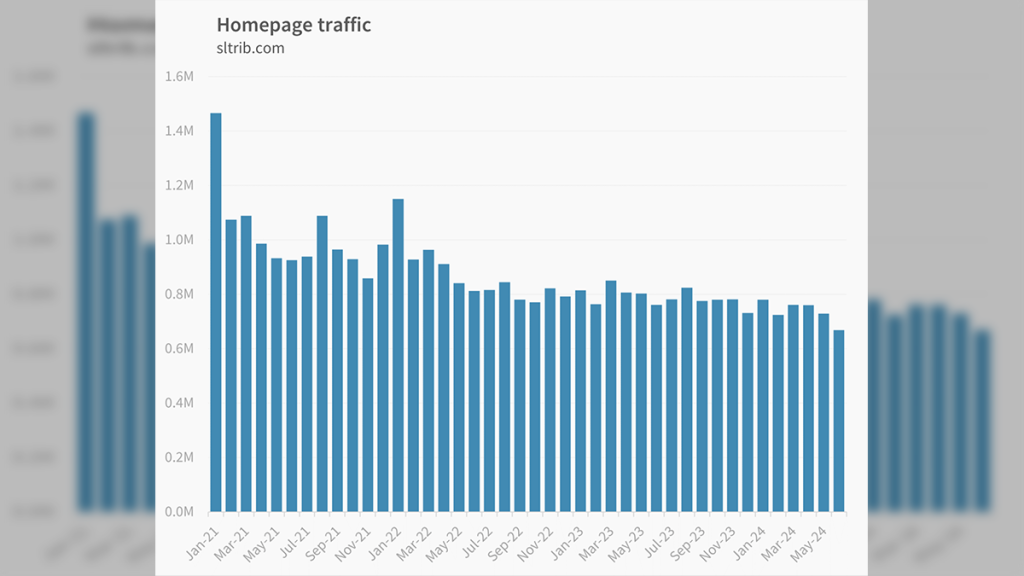
Homepage traffic for sltrib.com from Jan 2021 until May 2024
Redesigning the article page for local news
The Salt Lake Tribune is building a toolkit to help you optimize article pages for enhanced reader engagement and support
The importance of the article page has been increasing for years, yet many local publishers lack the resources to optimize this entry point for their audience.
Larger and national publishers have rethought their article pages in response to changes in social and search referrals, resulting in more engaging experiences for users entering directly via articles rather than the homepage. However, these adjustments are often limited to their own brands and proprietary CMS.
Local publishers face similar user shifts and challenges. For example, only 17% of our traffic at The Salt Lake Tribune goes through our homepage, with the rest coming on a story-by-story basis. Due to constrained resources, many newsrooms our size and smaller have not been able to optimize the article page for it to be the readers site entry.
It’s essential to rethink the user experience on our news sites to better weather shifts to search and social. As business models rapidly evolve, local publishers need to grow newsletters, encourage donations, seek subscriptions, and maintain room for sponsorships or advertising. We must create a solution that is modular and paired with tests, learnings, and design theory to be widely implementable.
Through this fellowship, I will create an article page design system that helps newsrooms present reporting in rich, multimedia formats and provides audiences with the utility once held by homepages. This customizable system will encourage conversions to deeper forms of support and readership, critical to local media companies’ business models.
As one of the first legacy newspapers to become nonprofit at the same time as transitioning to a digital-first operation, The Salt Lake Tribune is uniquely positioned to address this problem. We balance long-term audiences with new ones, we have both subscriber and donor user journeys, traditional advertising and philanthropic underwriting.
The tools I create, and our learnings, will be applicable to almost all news sites.
The beginning: What we’re doing
I’ll be working on several tracks for this project: industry research (which includes interviewing stakeholders in my newsroom,) reader research and analysis, and A/B testing. These efforts will help us understand user needs and refine our approach to optimizing article pages for all.
So far, I’ve laid the groundwork for my project. I’ve written to innovators and industry leaders in news products. I’ve conducted interviews with them and leaders within my newsroom, all while doing my own extensive research.
One valuable piece of advice I received was from Feli Carriqure at News Product Alliance: constantly ask yourself “Why?” As I questioned the why, I determined what I currently know and what is still to be learned. From Feli’s presentation on audience research during our fellowship kickoff, I discovered the pillars of getting to know your audience using analytics, surveys, and interviews.
Homepage traffic has been decreasing since 2021, a trend noted in the graph above. Our analytics show that more users are entering our website on a story-by-story basis. From this conclusion and homepage research, I created a wireframe (a visual representation of a product’s layout that shows the structure and key elements) with article features to test.
However, in the spirit of always asking why, I realized this is also a great opportunity for reader feedback. I created a user survey for our readers, both subscribers and non-subscribers, to better understand what they need and want from an article page. With this information, I expect to refine my wireframe based on feedback from the people who will interact with the product daily.
Next steps
Some features will need A/B testing regardless of user feedback. These include key components of an article page like donation asks, newsletter signups, and ad placements, crucial to any newsroom’s revenue.
In my interviews, I spoke to Sisi Wei, a previous RJI Fellow who is currently Chief Impact Officer at CalMatters and the Markup. She referred me to an interesting article from The Guardian’s findings on reader revenue, featuring an interview with Steve Sachs, managing director at The Guardian, on their success with web versus email donation asks. One of my main goals is to test several donation ask placements and web designs for performance. Similarly, I plan to test newsletter sign-ups for the best placement within the article page to determine optimal adoption.
After meeting with my Chief of Content, Danyelle White, Chief Development Officer, Ciel Hunter and Product Lead, Antonio Ramirez, we concluded that ads and ad placement would also be incredibly valuable to test, given that more small newsrooms are adopting a revenue model that blends advertising and philanthropy.
All good product research starts with a question. The question here being, why the article page? Rethinking the article page is a pivotal step in redefining how local news publishers engage with their audiences and sustain their operations.
By helping you optimize your article page, we aim to create a more effective entry point for readers, fostering deeper engagement and increasing support through donations, subscriptions, and advertising. The insights gained will not only benefit The Salt Lake Tribune, but provide a scalable model with easily implementable pieces for many news organizations.
Cite this article
Partida, Alex (2024, Aug. 1). Redesigning the article page for local news. Reynolds Journalism Institute. Retrieved from: https://rjionline.org/news/redesigning-the-article-page-for-local-news/
